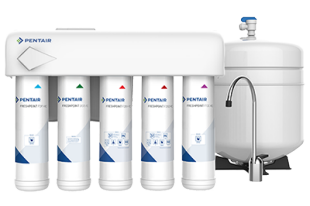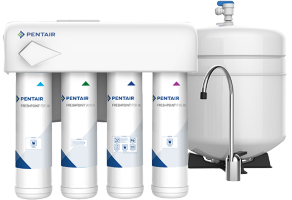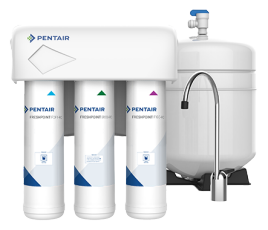- Water Softening & Filtration Systems
- Education
- Learn About Reverse Osmosis
Reverse osmosis water systems, often abbreviated as “RO” systems, can effectively treat the water of private homeowners and commercial businesses alike. The sheer amount of contaminants reduced by reverse osmosis systems make these filters a top choice year-after-year. So, what is RO, exactly? And how can it transform your tap water?
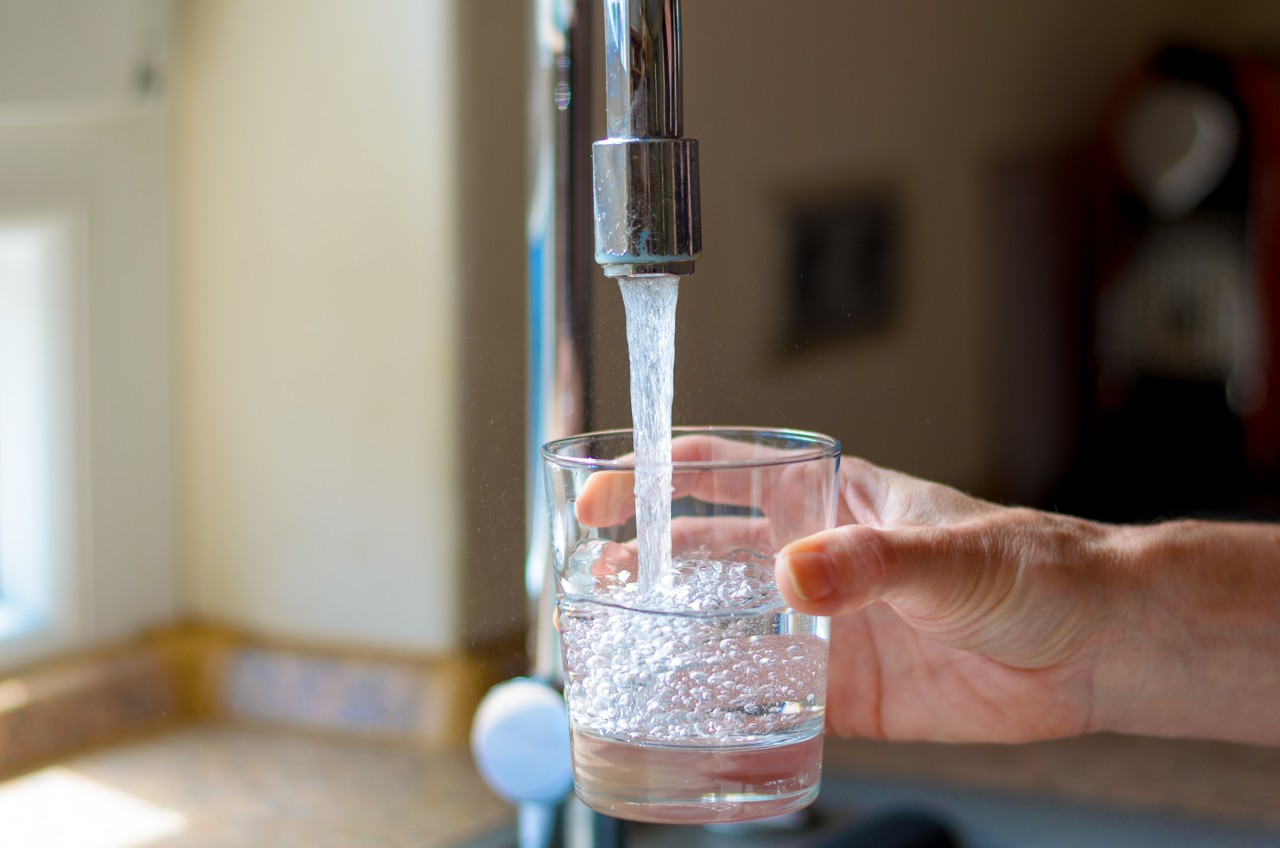
What is reverse osmosis?
Reverse osmosis is a pressure-driven general water treatment process that uses a membrane to separate dissolved minerals and contaminants from water. Other types of water treatment solutions include water softening, UV treatment, and whole house filtration.
According to the U.S. Food and Drug Administration, scientists have known about reverse osmosis for more than a century. But, it wasn’t until the ‘60s that laboratory scientists developed a usable membrane to apply to a variety of useful endeavors, like: desalination, mineral reclamation, and water filtration, just to name a few!
In the simplest terms, RO treats water by pushing it through a membrane, separating large contaminants on the other side of the membrane so that only better, higher-quality water makes it to your tap.
Think of reverse osmosis as a screen door for your water. You don’t want those flies buzzing into your front door, but you do want to feel that gentle afternoon breeze. In a similar way, reverse osmosis blocks many types of unwanted contaminants from making their way into your glass.
How does reverse osmosis work?
Before we dive into the deep end with reverse osmosis, let’s back-track through osmosis first.
01 Understanding osmosis
Osmosis is a naturally occurring phenomenon in which a solution with a lower concentration of impurities will migrate to a higher concentration solution therefore balancing the concentration throughout the entire solution.
A semipermeable membrane is a barrier through which some particles can pass, but not all. If you have two water solutions separated by a semipermeable membrane, water from the more diluted solution will migrate to the less diluted side until they’re equally diluted.
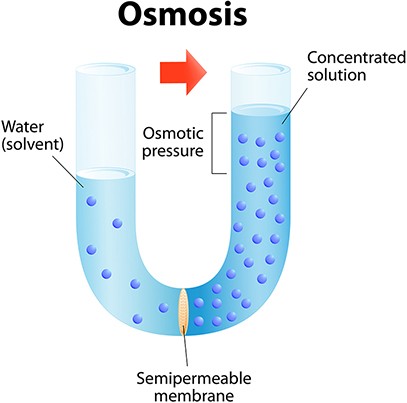
02 Reverse osmosis
RO reverses the process using energy (pressure) to push solutions with high concentrations of contaminants through a semipermeable membrane to remove the unwanted molecules and contaminants from your drinking water, but allows the passage of water molecules through. RO treatment systems, like the ones we manufacture at Pentair, serve you with refreshing and better-tasting water. In a flash, your water becomes deionized, demineralized, and desalinated. The membrane reduces unwanted contaminants and sends them down the drain.
As a result of how the process works, a particle’s size, molecular charge, and polarity will determine whether or not the membrane can filter it. Total dissolved solids (hardness, salts, inorganic contaminants) cannot be reduced by mechanical or standard carbon filtration but can be reduced by a reverse osmosis water treatment system and is one of the most comprehensive water treatment methods.
Reverse osmosis membranes (nanofiltration and nonporous RO membranes) can reduce contaminants that are as small as 0.001 microns. For comparison, Industrial Specialties Manufacturing estimates that a single particle of beach sand measures between 62.5 and 2,000 microns.
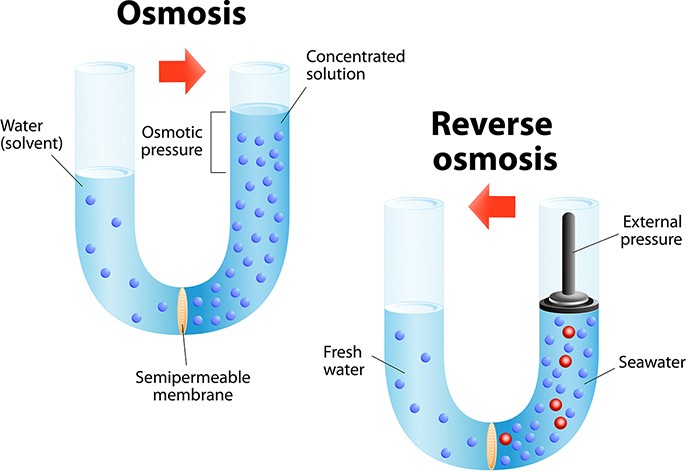
What does Reverse Osmosis reduce?
Size, charge, and molecular polarity matters, especially where reverse osmosis is concerned. The pores in the semipermeable membrane of Pentair reverse osmosis water systems are so tiny they can reduce dozens of common contaminants at a rate of 98% or greater. Pentair reverse osmosis systems potentially can reduce a broad range of most particles, dissolved salts, organic molecules, and bacteria from your drinking water.
The Environmental Protection Agency (EPA) does regulate municipal water treatment facilities that treat your tap water to reduce a variety of primary and secondary water treatment contaminants. However, the EPA does not monitor or regulate a significant number of contaminants that RO can reduce from your water.
Does RO reduce fluoride?
Yes, because fluoride molecules are larger than water molecules, RO will reduce fluoride concentrations depending on the RO membrane. According to the Centers for Disease Control and Prevention (CDC), about two-thirds of homes in the U.S. that are supplied with community water systems receive fluoride in their tap water. The government implemented this initiative to prevent tooth decay. However, now that most people use fluoridated toothpaste, you may not want this chemical in your drinking water. The World Health Organization (WHO) recommends a maximum fluoride value of 1.5 mg/L in drinking water as a level at which the risk of fluorosis is low. The reduction of fluoride is just one benefit of an RO system.
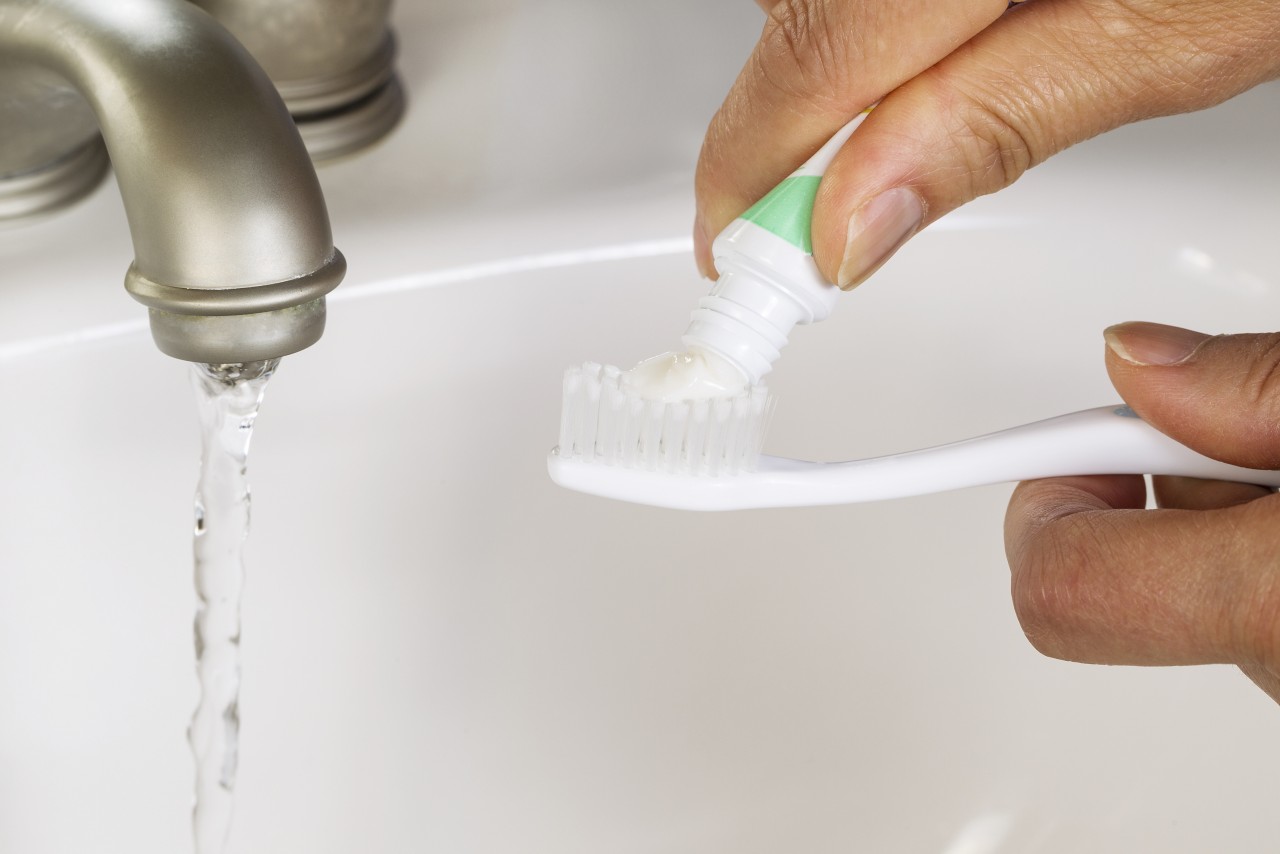
Does RO reduce chlorine?
Municipal water systems add chlorine to your drinking water to reduce waterborne viruses, bacteria, and protozoa. But there’s no reason for you to drink it once it’s in your home. In fact, we delivered the lowdown on chlorine treatment on a separate education page.
Does RO reduce minerals?
If vitamins and minerals are part of your diet, you know that minerals aren’t necessarily bad for you. Some minerals are essential for a strong, healthy body. However, because reverse osmosis is so effective, it separates out minerals like calcium and magnesium that can be beneficial to your health but are the main components that cause hardness in water. Pentair offers a remineralization cartridge that adds some of these “good” minerals back into your water.
What are the benefits of reverse osmosis?
You can’t put a price on peace of mind. Our line of reverse osmosis water systems delivers stunning water quality by reducing several common water contaminants by 98% or more. Here’s why we recommend homeowners worried about multiple contaminants go with reverse osmosis:
It targets the tricky contaminants.
Contaminants like heavy metals, sodium, and various chemicals are difficult to treat with standard filtration methods. The power of reverse osmosis coupled with the semipermeable pores and microscopic size means that you protect your home from a handful of the water contaminant bad guys.
There are multiple stages of treatment.
The membrane is just one of multiple stages of treatment. A sediment filter reduces small sediment and dirt to protect the entire system. A carbon filter reduces contaminants such as chlorine. Other stages polish your water and add beneficial minerals back in.
Ultimate innovation for ultimate convenience.
You can easily install our compact RO systems under your kitchen sink. Minimal tools or maintenance are required. All you need to do is swap out the cartridges about once per year.
Our FreshPoint RO platform reduces the amount of water released down your drain by 50% compared to other RO systems in the market. The semipermeable membrane can filter up to 50 to 75 gallons of water per day (depending on the system), delivering unrivaled water flow from your faucet.
Reverse Osmosis Water Systems For Your Home Water
Equip your home with your water’s new best friend, end to end. Here are our top-tier reverse osmosis systems:
FreshPoint GRO-575 Five-Stage Reverse Osmosis System – Kiss contaminants goodbye with five stages of high-quality water filtration system. Your family benefits from added protection against pesticides like atrazine and volatile organic compounds like industrial cleaners with extra treatment stages. The FreshPoint 5-Stage Under Counter RO System puts the power and control in your hands.
FreshPoint GRO-475 Four-Stage Reverse Osmosis System – Elevate your home filtration to experience high-quality water. With four reverse osmosis stages, your home drinking water will have reduced levels of pesticides like lindane and atrazine for proven taste and quality. Enjoy a fresh take on filtration: order a FreshPoint 4-Stage Under Counter RO System that works as hard for your family as you do.
FreshPoint GRO-350 Three Stage Reverse Osmosis System – Experience worry-free water in a snap. Our unique "click and enjoy'' design simplifies cartridge exchange with technology certified to provide excellent water. The GRO-350 is a three-stage reverse osmosis system that reduces many contaminants, including lead, fluoride, dissolved solids, and cysts.
When it comes to reverse osmosis, the smaller, the better. With pores measuring as small as 0.001 microns, you’ll trap nearly everything in your water’s path. That’s the power of reverse osmosis: unrivaled water treatment and unbeatable peace of mind.



